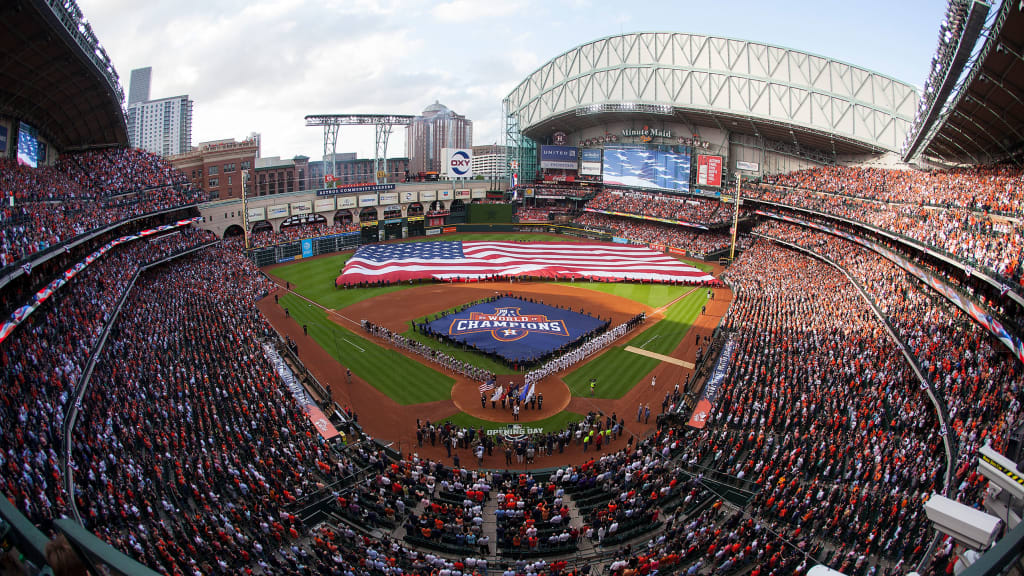
HOUSTON -- The question whether the retractable roof will be open at Minute Maid Park is moot for most of the season, when the hot and humid weather in Houston pretty much solidifies baseball will be played in air-conditioned comfort from mid-May through the end of September.
In the early years of Minute Maid Park, which opened as Enron Field in 2000, the club would peel back the roof after the sun went down on a nightly basis if rain wasn’t in the forecast. The end of games were played under the stars, though the summer’s searing humidity could still make it feel quite uncomfortable. That ended after the 2005 season.
These days, the roof is usually only open in April and into May before it gets too hot. The weather is cool enough for the Astros to open the roof occasionally into October if they make the playoffs (and if Major League Baseball allows it), but the club -- and the players -- would rather take the elements of it and keep it closed. It also doesn’t hurt that it helps keep the crowd noise inside, too.
So what are the rules for opening or closing the roof?
The decision to play with the roof open or closed in the regular season lies with the Astros, but if the game begins with the roof open, it can be closed only in the event of impending rain or other adverse weather conditions. If the club decides to close the roof, it will have to get permission from the umpiring crew chief in consultation with the visiting club. Once the roof is closed, though, it can’t be re-opened.
The roof can only be opened between innings. It takes about 14-20 minutes for the retractable roof at Minute Maid Park to be slid open. The Astros say the roof is opened and closed about 160 times a year, covering 14.6 miles in distance.
According to the Astros, the roof is closed for the threat of rain, the threat of sustained winds above 30 mph, temperatures below 65 degrees for a night game and air temperature or heat-index readings above 88 degrees for a night game or 84 for a day game. That caused some controversy at the 2005 World Series.
After the Astros lost the first two games of the Fall Classic in Chicago to the White Sox, the series shifted to Houston for Game 3 and the weather was mild. The Astros planned to keep the roof closed to help increase crowd noise, but Commissioner Bud Selig ruled the roof was to be opened because the weather was consistent with conditions that led the Astros to open the roof during the regular season.
That didn’t sit well with the players.
“It was a little frustrating how they made us open the roof,” Astros infielder/outfielder Chris Burke said. “That was a huge part of our home-field advantage, and we were all pretty frustrated. Why they would want to take away our home-field advantage?”
The Astros lost a pair of close games to the White Sox in Games 3 and 4 and were swept in the World Series. The open roof likely played little or no factor in the outcome of the series, but the club had the roof closed during its entire playoff runs in 2017-19 at Minute Maid Park.
In 2020, for the first time in franchise history, the Astros didn’t open the roof in the regular season. The season, which was shortened to 60 games because of the coronavirus, was played without fans in Houston, so fan comfort wasn’t a consideration. The players preferred to have it closed, so the Astros played all 28 home games that season with the lid shut.
In the first 20 years of the ballpark (2000-19), the Astros played 1,614 regular-season games at Minute Maid Park and the roof was closed 68.3 percent of the time (1,103). They played just 366 games with the roof open (22.7 percent) and 145 with the roof open and closed (9 percent).
And maybe the players had a point. The Astros had a .553 winning percentage with the roof closed and a .503 percentage with it opened during that span.
"That's how we play most of the games here," pitcher Lance McCullers Jr. said before Game 3 of the 2017 World Series. "We're very used to it. I definitely think it's part of our home-field advantage. We play like 60 or more like that, so we're very accustomed to it, which is, I think, why a lot of the guys want it to stay the same."
